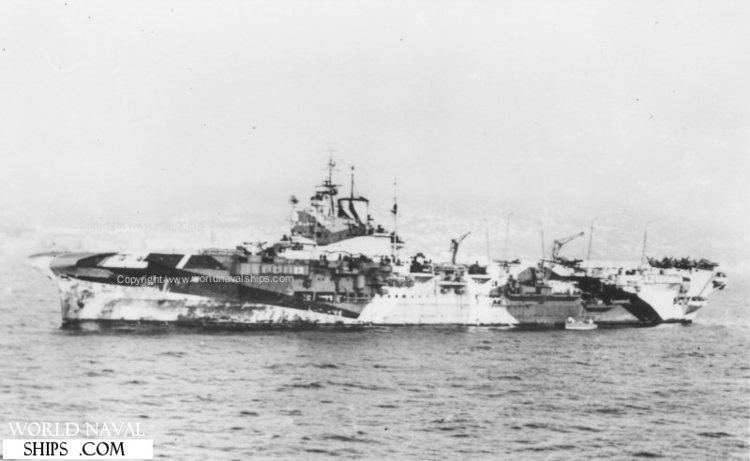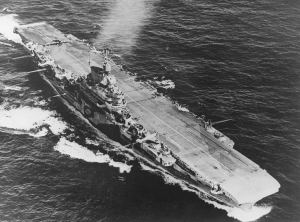Name HMS Indomitable Laid down 10 November 1937 Construction started 10 November 1937 Length 230 m Beam 29 m | Ordered 6 July 1937 Commissioned 10 October 1941 Fate Sold for scrap in 1955 Launched 26 March 1940 Draft 8.8 m Builder Vickers-Armstrongs | |
 | ||
HMS Indomitable (pennant number 92) was a modified Illustrious-class aircraft carrier of the Royal Navy. The Illustrious class was developed in the 1937 Naval Programme. Originally planned to be the fourth of the class, she was redesigned to enable her to operate more aircraft, 48 instead of 36. A second hangar was added above the original, raising the flight deck by 14 feet (4.3 m), although the hangar side armour had to be reduced to compensate. Part of the lower hangar was converted into extra workshops and accommodation to support the added aircraft.
Contents
- Construction and early history
- The Mediterranean
- The Far East
- Post war
- Decommissioning and disposal
- Battle honours
- References

Construction and early history

Indomitable was laid down by Vickers-Armstrong at Barrow-in-Furness, on 10 November 1937. She was launched on 26 March 1940 and commissioned the following year in October. She was christened by Clementine Churchill.

She sailed to the West Indies in November 1941 for her maiden voyage. While there, Indomitable ran aground on a coral reef near Jamaica, though she returned to service soon afterwards. It has been suggested that this short delay proved fatal for British plans for Singapore. There were provisional plans that Indomitable was to join HMS Prince of Wales and HMS Repulse in the port of Singapore as part of a deterrent force, Force Orange, against Japanese aggression in the Far East. However, given that the aircraft carrier was in the vicinity of Jamaica, on 3 November 1941, it seems unlikely that Indomitable could really have reached Singapore in sufficient time to provide air cover for the battle fleet. For that to have been achieved, it would have been necessary to order the ship to proceed to Singapore at a date earlier than 3 November. In the event, the other two capital ships, designated Force Z, did not have adequate air cover, and were sunk by Japanese aircraft when the Japanese landed in Malaya in December 1941. The following month, in January 1942, Indomitable joined the Eastern Fleet based at Ceylon (now Sri Lanka). At the end of January, she ferried 48 Royal Air Force Hawker Hurricanes to airfields in Sumatra in the Dutch East Indies, to reinforce the air defenses of Singapore, but a large proportion of the Hurricanes were destroyed on the ground by Japanese air raids. The British commanders in Singapore surrendered to the Japanese on 15 February.

After the fall of Britain's Far Eastern colonies (Hong Kong and Burma also fell) Indomitable was redeployed. A new Eastern Fleet was established under the command of Admiral Sir James Somerville. Indomitable, and her sister ship Formidable were the only modern aircraft carriers of the Fleet, and were a vital asset to the Allies in the Far East; the only other carrier, Hermes, was obsolete.
In April 1942 Somerville attempted to intercept the Japanese carrier strike force as they raided the Indian Ocean. Incomplete intelligence led him to abandon his ambush just hours before the Japanese force arrived. Over the next few days Indomitable was part of a force that attempted to intercept the Japanese fleet at night, where the slow but radar equipped, British torpedo planes would have the best chance of a successful strike. Despite several days of searching no decisive action was achieved and Somerville eventually withdrew his fast carriers to Bombay. Hermes, the Australian destroyer HMAS Vampire, the corvette HMS Hollyhock and two heavy cruisers, Cornwall and Dorsetshire, were sunk in action during this Japanese raid, as were a score of merchant ships.
In May 1942 the British launched Operation Ironclad, the invasion of French Madagascar. It was feared that the Japanese would themselves occupy Madagascar and use it as a submarine base to attack Allied convoy routes in the Indian Ocean.
Indomitable was detached from the Eastern Fleet to take part in the invasion, rendezvousing with the covering force (which included sister ship Illustrious) and the invasion force which had been sent from Durban, South Africa. The assault began on 5 May at Courrier Bay, just west of the actual objective of Diego Suarez. Indomitable's air wing attacked Arrachart airfield on the opening day of the invasion, destroying five Morane-Saulnier M.S.406 fighters and damaging two more as well as two Potez 63.11s. The following day a ground assault began, with Indomitable's Albacores bombing the defences and her Fulmars and Sea Hurricanes flying ground attack sorties. French forces in Diego Suarez surrendered on 7 May. On 8 May, the French submarine Monge attempted to torpedo Indomitable but was sunk by depth charges from the destroyers HMS Active and Panther.
The Mediterranean
In July, Indomitable returned to the United Kingdom. She was soon back in action, participating in Operation Pedestal, the largest convoy to supply the besieged island of Malta. This convoy comprised 14 cargo ships and an unprecedentedly large escort of warships: Cairo, Charybdis, Eagle, Indomitable, Victorious, Kenya, Manchester, Nelson, Nigeria, Phoebe, Rodney, Sirius and 32 destroyers. One objective was for Furious to launch her Spitfires to land at Malta where they would remain; this was done on 11 August and Furious returned to Gibraltar.
During the operation Indomitable was hit by two 500 kg bombs and suffered three near misses; a 500 kg bomb penetrated the unarmoured portion of the flight deck, causing damage that required her to withdraw for repairs, although she was able to steam at 28.5 knots (52.8 km/h; 32.8 mph) fewer than two hours after the hits. She sailed to the United States, where repairs were completed in February 1943, after which she immediately returned to the Mediterranean. She was torpedoed either by a Savoia-Marchetti SM.79 of 204a Squadriglia of the 41st Torpedo Bomber Group (captain Carlo Capelli, lieutenant Ennio Caselli) or by a Junkers Ju 88 bomber on 16 July while supporting the buildup for the Allied invasion of Sicily (Operation Husky) and returned again to the United States where repairs were completed. She commenced sea trials 10 April 1944.
The Far East
Indomitable returned to the Eastern Fleet in early 1944. She and Victorious launched bombers against Sumatra in August and September. They later bombed the Nicobar Islands, after which Indomitable joined up with Illustrious to attack Medan and Sumatra again on 20 December. The following year, Indomitable joined the British Pacific Fleet. On 4 January 1945 she, her sister ship Victorious and another fleet carrier Indefatigable attacked Medan. Subsequent actions were taken against Palembang and Sumatra, later in January. On 4 May 1945 she was hit by a kamikaze but her armoured flight deck saved her from serious damage. In August, with the war ending, Indomitable supported the liberation of Hong Kong, arriving after a landing party from HMCS Prince Robert had taken the Japanese surrender. Her aircraft flew the carrier's last combat missions of the war and of her career on 31 August and 1 September against Japanese suicide boats which were attacking British forces.
Post war
Indomitable returned to the UK in November 1945. The following year she carried the Great Britain national rugby league team to Australia on their first post-war tour, earning the team the nickname, 'The Indomitables'. In 1947, she was placed in reserve, and then given a refit that took three years, from 1947 to 1950. Late in her refit her boilers were discovered to have only 10 years of life, and the engine spaces had to be torn apart and rebuilt to replace the boilers. Upon the completion of her refit she returned to operational duty with the Home Fleet in far cooler climates than her wartime operations. She was unique in carrying the day and night de Havilland Hornet fighter, and also included the Blackburn Firebrand torpedo strike aircraft in its airgroup. On 3 February 1953, she was badly damaged by an internal fire and explosion; the damage was later covered in concrete, and was never repaired. In the same year she sailed to take part in the Fleet Review to celebrate the Coronation of Queen Elizabeth II. She then did deck landings in the channel, with experimental landing lights replacing the batman. Indomitable was not modernized for several reasons, paramount of which was that to make her capable of handling jet aircraft, her hangar height would have to be increased from 14 feet (4.3 m) to 17.5 feet (5.3 m). This would require tearing the ship down to the hangar deck itself. Given the escalating costs of the modernization of her half-sister Victorious, the Admiralty decided against a complete modernization for a ship of her age.
Decommissioning and disposal
Indomitable returned to the reserve fleet and in October 1953 she was placed in unmaintained reserve. She was sold for scrap and arrived at Faslane for breaking up on 30 September 1955.
